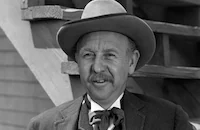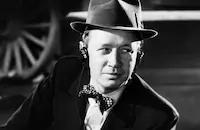Take a Letter, Darling
Brief Synopsis
Cast & Crew
Mitchell Leisen
Rosalind Russell
Fred Macmurray
Macdonald Carey
Constance Moore
Robert Benchley
Film Details
Technical Specs

Synopsis
Having depleted his private income, artist Tom Verney accepts a job as private secretary to a tough female advertising executive named A. M. MacGregor. Tom finds his position humiliating because "Mac" uses him as a foil for her clients. One night, she pretends he is her fiancé to outwit the jealous wife of a client, and on another evening, uses him to captivate the interest of Ethel Caldwell, a racy Southerner whose brother Jonathan is a wealthy tobacco manufacturer who hates women. Trouble arises when Mac, who has fired her previous male secretaries for trying to seduce her, finds herself falling in love with Tom, but refuses to acknowledge it. In order to get the Caldwell account, Tom agrees to pretend that he is an advertising executive after Mac promises him a $10,000 bonus, which Tom would then use to buy a house in Mexico and paint. Tom accepts Ethel's invitation to work on the cigarette campaign at the Caldwell mansion in the South, and while he and Ethel entertain each other, Mac steams with jealousy in New York. Mac finally goes to the Caldwell home herself, to the delight of Jonathan, who in spite of his distrust of women, has fallen deeply in love with her. Tom confides in Jonathan that he is in love with Mac and that Ethel has agreed to allow him to use their platonic friendship to make Mac jealous. Jonathan then serves his own interests by encouraging Tom to continue his tactics until Mac becomes so angry at Tom that she accepts Jonathan's marriage proposal. Having developed a clever advertising campaign and gotten a signed contract from the Caldwells, Tom returns to New York. One day, Mac's ineffectual partner, G. B. Atwater, brings Tom his bonus and advises him that although Mac and Jonathan's wedding is set, Mac is miserable. Tom sends a semi-nude portrait of Mac as a wedding gift, and the Caldwells assume that Mac posed for the painting. Mac denies the accusation, but when she realizes that Jonathan does not believe her, she breaks the engagement and walks out. Later, Mac encounters Tom in a car pulling a trailer and angrily throws stones at him. When a train threatens to crash into the car on some railroad tracks, however, both Tom and Mac jump into the car and head for Mexico together.

Director

Mitchell Leisen
Cast

Rosalind Russell

Fred Macmurray

Macdonald Carey
Constance Moore

Robert Benchley

Charles Arnt

Cecil Kellaway
Kathleen Howard
Margaret Seddon

Dooley Wilson
George H. Reed

Margaret Hayes
Sonny Boy Williams
John Holland
Florine Mckinney
Amo Ingraham
Dorothy Granger
Katharine Booth
Lynda Grey
Keith Richards
Jack Rice
Lorin Raker
Jean Del Val
Jacques Vanaire
Douglas Dean
Janet Graves
Francis Sayles
Arthur Loft

James A. Millican
George Dolenz
Isabel Randolph
Georgia Backus
Reginald Sheffield
Reginald Simpson
Virginia Brissac
Stanley Mack
Pat West

Eddie Acuff
Betty Farrington
Nell Craig
Robert Winkler
Dave Willock
Thomas W. Ross
Harry Lamont
Sid D'albrook
Mrs. Wilfrid North
Ronnie Rondell
Marshall Ruth
Roy Crane
Bertha Powell
Marta Downes
David James
Florence Wix
Crew
Francisco "chico" Alonso
Roland Anderson
George Beck
Claude Binyon
Sam Comer
B. G. Desylva
Hans Dreier
Doane Harrison
Irene
Fred Kohlmar
Mitchell Leisen
John Mescall
Harry Mills
Richard Olson
Thomas Scott
Cullen Tate
Wally Westmore
Victor Young

Videos
Movie Clip



Film Details
Technical Specs

Award Nominations
Best Art Direction
Best Cinematography
Best Score
Articles
Take a Letter, Darling
Producer: Mitchell Leisen
Director: Mitchell Leisen
Screenplay: Claude Binyon; George Beck (story)
Cinematography: John J. Mescall
Art Direction: Roland Anderson, Hans Dreier
Music: Victor Young
Film Editing: Doane Harrison, Thomas Scott
Cast: Rosalind Russell (A.M. MacGregor), Fred MacMurray (Tom Verney), Macdonald Carey (Jonathan Caldwell), Constance Moore (Ethel Caldwell), Robert Benchley (G.B. Atwater), Charles E. Arnt (Fud Newton), Cecil Kellaway (Uncle George), Kathleen Howard (Aunt Minnie), Margaret Seddon (Aunt Judy), Dooley Wilson (Moses), George Reed (Sam French), Margaret Hayes (Sally French), Sonny Boy Williams (Micky Dowling), John Holland (Ex-Secretary).
BW-92m.

Take a Letter, Darling
Quotes
You're a beautiful brain and beautiful clothes. No temperature, no pulse. That's all.- Tom Verney
Where did you learn about women, Verney?- A.M. MacGregor
It isn't a matter of learning. It's instinct.- Tom Verney
I'm a brain with no pulse, eh? I'm a woman, Verney, more woman than you'll ever know.- A.M. MacGregor
Trivia
Notes
Although a Hollywood Reporter news item indicates that Preston Sturges was slated to direct this film, Sturges was in pre-production for his film The Palm Beach Story at the time, and it is doubtful that he did any work on Take a Letter, Darling. Hollywood Reporter news items also report that Claudette Colbert was originally assigned the lead role, with Frances Farmer in the second lead, and that Katharine Hepburn was also considered for the lead. A modern source notes that Colbert was recast in The Palm Beach Story, due to that film's casting difficulties. Paramount Production Information from the AMPAS Library reveals that the "semi-nude" painting seen in the film was painted by Phil Paradise. The closing scene was shot near the intersection of Oxnard Avenue and Woodman in Van Nuys, CA; and the pool scene was shot in Beverly Hills at the home of Max Strauss. Backgrounds were filmed at Lake Arrowhead and Bear Valley, and other scenes were filmed at Busch Gardens in Pasadena, CA. This film was nominated for Academy Awards in the following categories: Best Art Direction/Interior Direction (Black and White), Hans Dreier, Roland Anderson/Sam Comer; Best Music (Scoring of Dramatic or Comedy Picture), Victor Young; and Best Cinematography (Black and White), John Mescall.














